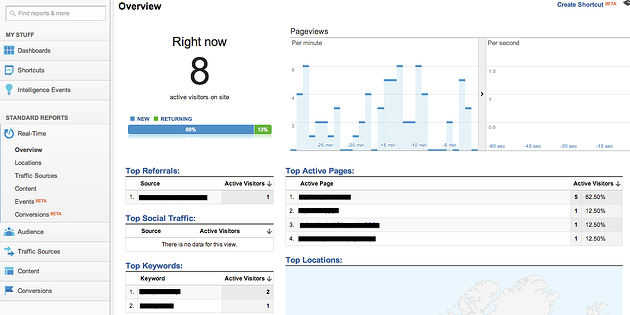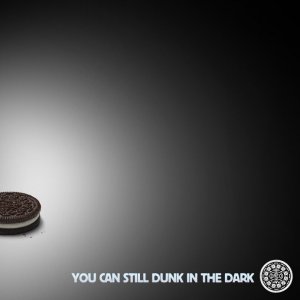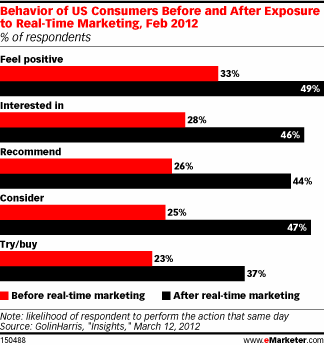The following post originally appeared in WorkIt Richmond, an online resource for small business owners in central Virginia.
In a world of 24-hour news coverage and constant social connectivity, information and communication has become instantaneous. With this, marketers are forced to make quick decisions with fast information. The following is a glimpse into how quickly consumer insight is gathered, how that information is used, and the impact those decisions are having on consumers.
Real-time Analytics:
Real-time analytics allows webmasters and marketers to view their website’s data in real time, as it happens. While it used to take several hours for website reports to populate with the latest information, real-time reports are instantaneous.
In 2011, this feature was introduced into the free version of Google Analytics. If you’ve never spent any time in your site’s real-time analytics, log into your Google account, click Real-Time in the left sidebar, and take a moment to see what’s happening on your website right now.
What you can see in real-time:
Google’s real-time analytics shows several things including: how many people are currently viewing your site, where they’re located geographically, the pages they’re viewing, how they found your site, and if they’re completing any of your site’s goals. Don’t expect to find any personal information, though. Remember: all data in Google Analytics is anonymous.
Watching events as they happen:
Real-time analytics reports can become a spectacle when a site gets sudden, heavy promotion. This is a screen shot of real-time analytics as a site received a plug during a national news broadcast:
So what?
While this may look interesting (and believe me, it’s very exciting to watch as it’s happening), it doesn’t pass the “so what” test. That is, you can watch the surge of visitors pour onto your site, but so what?
The reality is, real-time analytics are useless without real time action.
Real-time marketing:
Real-time marketing, or marketing executed “on-the-fly” to specific customers at specific moments in time, isn’t a new concept. Born from the early days of CRM, or Customer Relationship Management solutions, real-time marketing has taken on new life with the mass adoption of social media. The challenge of conceiving and executing marketing ideas in a matter of minutes is compounded by the very short and sudden life of most Internet events. Taking too long to act is like showing up to Friday’s party on Saturday.
Seizing the opportunity begins with having your finger on the pulse of what’s taking place at that very moment - whether it’s an offline event like the Super Bowl or witnessing a sudden influx of traffic to your website from a particular source.
Next, marketers must act quickly to decide if and how real-time action can capitalize on what’s taking place. Finding the right balance between timeliness and relevance can be very challenging, but the rewards can be astronomical.
The next level of marketing:
The costs associated with having a marketing and digital team ready to respond and execute at a moments notice does not come cheap. For this reason, several brands choose to only execute real-time strategy during major offline events, when consumer eyeballs are most likely to be in the same place. Take for instance Oreo’s brilliant play during the black out at this year’s Super Bowl:
While other Super Bowl ads were months in making, spending millions of dollars for a 30 second slot, the above ad was conceived, produced, and approved within minutes then tweeted to Oreo’s 80,000 Twitter followers. The tweet was then re-tweeted an estimated 16,000 times. In the world of competitive advertising, Oreo was the considered by many the winner of the night with this single, timely tweet.
The Oreo tweet is a great example of real-time response and execution; however, capitalizing on real-time events is not limited to fast Photoshop skills and a Twitter account. Producing micro-sites over night, changing your site’s homepage, launching a topical display ad campaign, or posting a relevant text status update can all achieve real-time marketing nirvana.
How does real-time marketing influencing consumers?
The survey results produced by eMarketer (shown above) indicate consumer behavior and sentiment improves following exposure to a real-time marketing event. Note that this is meant to indicate how a respondent feels the same day they experienced the real-time marketing. So, not only is the window to produce a message incredibly short, but the impact the message has could also be short lived. To combat this, marketers must be prepared to offer immediate conversion opportunities in order to maximize their chances for success.
Utilizing real-time analytics to produce real-time marketing is a paradigm shift in how brands should strategize and execute marketing campaigns. It is not yet a replacement to traditional marketing, but rather another strategy to deal with the ever-evolving and fast-paced digital world.









Agree, disagree, or just have something to add?
Leave a comment below.